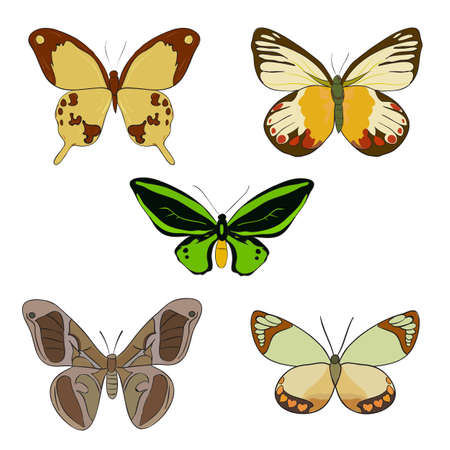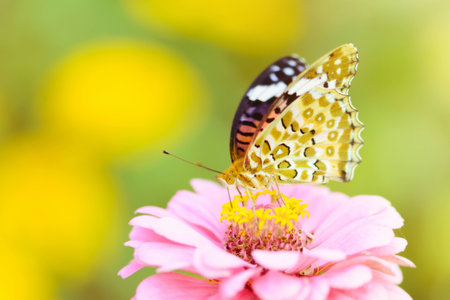Introduction to British Butterflies
In the tapestry of British wildlife, butterflies have always held a cherished place. Their delicate beauty and gentle fluttering evoke memories of childhood summers spent in gardens, meadows, or strolling along hedgerows. For generations, these colourful insects have inspired poets, gardeners, and nature lovers alike across the UK. Perhaps it’s the fleeting nature of their presence—here one sunny afternoon, gone the next—that makes each sighting feel so special.
Butterflies are more than just a welcome sight; they play an important role in our ecosystems as pollinators and as indicators of environmental health. Across Britain, over 59 species can be found, though not all are regular visitors to our gardens. Some of the most common species that grace both urban plots and the wider countryside include the peacock, with its striking eyespots; the small tortoiseshell, a familiar friend on buddleia bushes; and the cabbage white, often seen flitting around vegetable patches. The red admiral and painted lady also make regular appearances during the warmer months, while meadow browns and gatekeepers favour grassy verges and open fields.
Each species brings its own story, tied to local landscapes and traditions. Whether you’re pottering about in your back garden or rambling through a country lane, keeping an eye out for these winged visitors is part of what makes British summers truly magical.
2. The Lifecycle of a British Butterfly
Understanding the lifecycle of our native British butterflies is a bit like watching a well-rehearsed play unfold, with each stage perfectly set for the next. From the humble beginnings of a tiny egg to the emergence of a striking adult butterfly, every step is vital. Let’s walk through this fascinating journey together, focusing on those species you might spot fluttering across your garden or local park.
Step 1: The Egg – A Quiet Beginning
The lifecycle starts when a female butterfly carefully lays her eggs, often choosing the underside of leaves from plants specific to her species. For example, the Common Blue prefers bird’s-foot trefoil, while the Peacock favours nettles. These eggs are minuscule and can be spherical, oval, or ribbed depending on the butterfly.
Step 2: Caterpillar (Larva) – The Hungry Phase
After about one to two weeks, the egg hatches into a caterpillar. This is when things get lively! The caterpillar spends most of its time eating—munching away at host plants to fuel rapid growth. British caterpillars can be green, brown, or even striped with spikes for protection from birds. They shed their skin several times as they grow; this process is called moulting.
Common Host Plants for British Butterflies
| Butterfly Species | Preferred Host Plant |
|---|---|
| Small Tortoiseshell | Nettle |
| Common Blue | Bird’s-foot Trefoil |
| Red Admiral | Nettle |
| Brimstone | Buckthorn |
| Meadow Brown | Grasses (meadow and fescue) |
Step 3: Chrysalis (Pupa) – The Great Transformation
This stage often goes unnoticed by most gardeners. Once fully grown, the caterpillar finds a safe spot—often attached to a stem or tucked under a leaf—and forms a chrysalis (also called a pupa). Inside this casing, an astonishing transformation occurs: the caterpillar breaks down and reorganises itself into a butterfly over one to three weeks, depending on species and weather conditions.
Step 4: Adult Butterfly – Taking Flight in Britain’s Summers
The final act is truly magical. The adult butterfly emerges from its chrysalis, wings soft and crumpled at first. It pumps fluid into them and waits for them to harden before taking its first flight. Adult butterflies have only a few short weeks to feed on nectar, mate, and lay eggs, ensuring the next generation continues. Many British butterflies are seen from late spring through early autumn—timing their life cycles with our temperamental weather.
A Quick Glance at the British Butterfly Lifecycle Timeline
| Stage | Duration (Typical UK Season) |
|---|---|
| Egg | 1–2 weeks (April–June) |
| Caterpillar (Larva) | 3–6 weeks (May–July) |
| Chrysalis (Pupa) | 1–3 weeks (June–August) |
| Adult Butterfly | 2–4 weeks (July–September) |
This remarkable cycle repeats year after year in gardens, meadows, and hedgerows across Britain—a testament to resilience and adaptation that we can all witness if we know where (and when) to look.

3. Seasonal Changes and British Weather
If you’ve lived in Britain for any length of time, you’ll know that our weather is a law unto itself. One minute it’s bright sunshine, the next, you’re reaching for your brolly. For butterflies, these unpredictable shifts are more than just a mild inconvenience—they’re a matter of survival. The British seasons have a profound impact on the lifecycle of our butterflies, influencing everything from when they emerge to how well they thrive.
Butterflies are highly sensitive to temperature changes and daylight hours. In a typical British spring, the first warm spells coax species like the brimstone and peacock out of hibernation. But a late frost or unseasonal cold snap can set them back, sometimes with devastating consequences for early broods. Summer brings longer days and abundant blooms—crucial for feeding caterpillars and adult butterflies alike. Yet, if the summer turns out to be cool and wet (as it so often does here), food sources dwindle and populations may struggle.
Autumn in Britain is a time of preparation. Some butterfly species, such as the red admiral, may migrate south to avoid the chill, while others enter diapause—a sort of suspended animation—to survive winter’s bite. Our winters, though milder in recent years, still pose significant challenges: heavy rain and storms can destroy overwintering habitats or wash away delicate pupae.
This ever-changing climate means British butterflies must be both resilient and adaptable. Their lifecycles are tightly linked to seasonal cues—timing their emergence to coincide with blossoming wildflowers or lush nettle patches. When weather patterns shift unpredictably, it throws this delicate timing off-kilter, sometimes resulting in fewer butterflies making it through to the next season.
As anyone who tends an allotment or garden will tell you, keeping an eye on local weather patterns isn’t just small talk—it’s vital knowledge passed down through generations. In much the same way, understanding how our seasons shape butterfly behaviour helps us offer better support: planting nectar-rich flowers for all weathers or leaving corners of the garden a little wild for shelter during sudden cold snaps.
4. Habitats and Food Sources in the UK
Across the rolling fields, woodlands, and cottage gardens of Britain, butterflies have flourished for generations, each species relying on specific habitats and native plants to complete their fascinating lifecycle. Understanding where our butterflies thrive, and which flora they depend on, is vital if we want to preserve these treasured insects for future generations.
Traditional British Butterfly Habitats
Butterflies are choosy about where they lay their eggs and feed. Here in the UK, several classic landscapes support rich butterfly populations:
- Meadows and Grasslands: Home to species like the Meadow Brown and Common Blue, these open spaces are rich in wildflowers.
- Woodland Glades and Edges: Dappled sunlight supports the Speckled Wood and White Admiral.
- Hedgerows: Acting as wildlife corridors, hedges shelter the Brimstone and Gatekeeper.
- Heathlands: These acidic habitats are favoured by the Silver-studded Blue and Grayling.
- Cottage Gardens: Managed with traditional planting, gardens can be a haven for Small Tortoiseshells and Peacocks.
Native Plants for Every Stage
Each stage of a butterfly’s life — from egg to caterpillar (larva), chrysalis (pupa), and adult — depends on particular plants. Caterpillars especially are fussy eaters, often needing specific ‘larval food plants’. Adults seek out nectar sources for sustenance. Below is a handy table highlighting which native British plants support some common butterflies throughout their lifecycle:
| Butterfly Species | Larval Food Plant | Nectar Source for Adults | Main Habitat |
|---|---|---|---|
| Peacock | Common Nettle | Buddleia, Thistle | Cottage Gardens, Hedgerows |
| Brimstone | Alder Buckthorn, Purging Buckthorn | Dandelion, Primrose | Woodland Edges, Hedgerows |
| Small Tortoiseshell | Common Nettle | Knapweed, Buddleia | Meadows, Gardens |
| Meadow Brown | Various Grasses (e.g., Fescues) | Clover, Dandelion | Meadows, Grasslands |
| Speckled Wood | Couch Grass, Yorkshire Fog | Bramble blossom, Ivy flowers | Woodland Glades |
| Silver-studded Blue | Heather, Gorse | Heather flowers, Bell Heather | Heathland |
The Importance of Native Flora and Traditional Management
If you look back to your grandparents’ time, you’ll recall meadows buzzing with life and hedges thick with blossom. Much of this richness came from leaving patches wild or following age-old practices such as haymaking after midsummer. Native plants not only provide food but also shelter from predators and harsh weather. When we plant native wildflowers or leave a corner of the garden untamed, we echo those traditions that kept butterfly populations healthy in the past.
5. Challenges Faced by British Butterflies
From the gentle meadows of Kent to the rugged hills of the Lake District, British butterflies are facing a host of modern challenges that threaten their very existence. Speaking as someone who has watched these delicate creatures flit about our gardens for decades, it’s clear that times have changed—and not always for the better.
Habitat Loss: A Shrinking Home
One of the most pressing issues is habitat loss. Over the years, we’ve seen wildflower meadows and hedgerows—once common sights in our countryside—disappear at an alarming rate. Whether it’s due to urban expansion, intensive farming, or changes in land management, these vital habitats are being replaced by concrete, crops, and manicured lawns. Without their native plants for food and breeding, butterflies like the Small Tortoiseshell and Common Blue find it harder to survive each season.
Pesticides: An Unseen Threat
Another concern comes from the widespread use of pesticides in both agriculture and private gardens. While these chemicals help keep unwanted pests at bay, they often don’t discriminate. Caterpillars and adult butterflies can be wiped out alongside the intended targets. I remember a time when you could count dozens of butterflies on a summer afternoon; nowadays, you’re lucky if a handful appear.
Climate Change: New Pressures Every Year
The changing climate brings its own set of problems. Unpredictable weather patterns—mild winters, early springs, and wet summers—can disrupt the finely tuned lifecycle of British butterflies. Some species may hatch too early or too late to find enough nectar or suitable plants for their larvae. Others struggle with shifting ranges as southern species move northward in search of suitable conditions, competing with local populations already under stress.
A Local Perspective
Here in Britain, these challenges aren’t just statistics—they’re part of our everyday reality. Gardeners now talk about “butterfly-friendly” spaces because we realise how much these insects need our help. Our parks and reserves are more important than ever as sanctuaries for struggling species. Each generation remembers more butterflies from their childhood than they see today—a gentle reminder that small changes in our habits can make a world of difference for these cherished insects.
6. How Everyday People Can Support Butterflies
Creating Butterfly-Friendly Spaces at Home
If you have even a modest patch of outdoor space, you can do wonders for local butterflies. The key is to grow native wildflowers such as primroses, cowslips, and buddleia—often called the butterfly bush for good reason. Avoid using pesticides or weedkillers, as these can harm caterpillars and adult butterflies alike. Let a corner of your garden grow a bit wild; nettles and long grasses are essential for many British species. Even a window box filled with nectar-rich plants can make a difference in urban areas.
Getting Involved in Community Efforts
Many hands make light work, as my gran used to say. Consider joining or supporting local wildlife groups like Butterfly Conservation or participating in the Big Butterfly Count each summer. Councils and community organisations often run meadow-planting days or workshops on wildlife gardening—these are excellent opportunities not just to help butterflies, but also to meet neighbours and learn from those with more experience.
Simple Acts That Matter
You dont need grand gestures. Making a small log pile provides shelter for overwintering chrysalises. Keeping water out in shallow dishes with stones allows thirsty butterflies to drink safely. Even just being mindful when mowing the lawn—leaving patches uncut until late summer—can protect eggs and caterpillars.
Tried-and-True Tips from Older Generations
Older relatives often have practical wisdom handed down through the years: plant nasturtiums along fences to attract Small Whites, leave apple cores outside for Red Admirals in autumn, or shake seed heads over bare earth before winter sets in. Such simple traditions, quietly practised for decades, are part of what keeps Britain’s butterfly populations going strong.
By weaving together these everyday actions—some new, some old—you’ll be doing your part to ensure that future generations can enjoy the sight of a Peacock or Brimstone fluttering across our gardens and parks.
7. Concluding Thoughts and Resources
If there’s one thing I’ve learnt from years of watching butterflies flit through British gardens and hedgerows, it’s that these delicate creatures are much more than just a pleasant sight on a summer’s day. Butterflies are vital indicators of our environment’s health, and the changes in their numbers and habits tell us much about the state of nature around us. Their lifecycle—from tiny eggs to bustling caterpillars, then transforming within their chrysalises before emerging as adults—reminds us how interconnected all life truly is. Supporting butterflies is not only about helping them; it’s about safeguarding our own natural heritage for future generations.
Thankfully, there are plenty of ways you can get involved beyond your own garden fence. Across the UK, several organisations and citizen science projects welcome your interest and support. Butterfly Conservation is the leading charity dedicated to saving butterflies, moths, and their habitats, offering practical advice and regular events. The Big Butterfly Count runs every summer, inviting people of all ages to spend just 15 minutes counting butterflies—an easy way to contribute valuable data about butterfly populations nationwide. The Royal Horticultural Society (RHS) also provides excellent resources on planting for pollinators and making your patch wildlife-friendly.
If you’re keen to pass on knowledge to young ones or community groups, many local Wildlife Trusts offer workshops and guided walks during butterfly season—an ideal way to foster curiosity and respect for nature. And don’t forget about resources like the UK Butterfly Monitoring Scheme (UKBMS), which welcomes volunteers for regular surveys in parks, woodlands, and even urban spaces.
The bottom line is simple: every small action counts. Whether you’re planting native wildflowers or logging sightings on your phone, you’re playing a part in a wider effort that stretches back generations. By cherishing butterflies today, we’re ensuring that future Britons will continue to marvel at their beauty and learn from their resilience. Let’s keep our countryside alive with colour—and be proud stewards of these remarkable insects.


